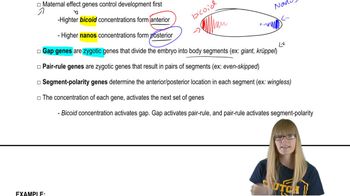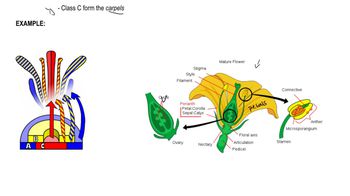Table of contents
- 1. Introduction to Genetics51m
- 2. Mendel's Laws of Inheritance3h 37m
- 3. Extensions to Mendelian Inheritance2h 41m
- 4. Genetic Mapping and Linkage2h 28m
- 5. Genetics of Bacteria and Viruses1h 21m
- 6. Chromosomal Variation1h 48m
- 7. DNA and Chromosome Structure56m
- 8. DNA Replication1h 10m
- 9. Mitosis and Meiosis1h 34m
- 10. Transcription1h 0m
- 11. Translation58m
- 12. Gene Regulation in Prokaryotes1h 19m
- 13. Gene Regulation in Eukaryotes44m
- 14. Genetic Control of Development44m
- 15. Genomes and Genomics1h 50m
- 16. Transposable Elements47m
- 17. Mutation, Repair, and Recombination1h 6m
- 18. Molecular Genetic Tools19m
- 19. Cancer Genetics29m
- 20. Quantitative Genetics1h 26m
- 21. Population Genetics50m
- 22. Evolutionary Genetics29m
14. Genetic Control of Development
Developmental Patterning Genes
Problem 5b
Textbook Question
Consider the even-skipped regulatory sequences in Figure 18.9.
Consider the binding sites for gap proteins and Bicoid in the stripe 2 enhancer module. What sites are occupied in parasegments 2, 3, and 4, and how does this result in expression or no expression?
 Verified step by step guidance
Verified step by step guidance1
Identify the role of gap proteins and Bicoid in the regulation of gene expression. Gap proteins are transcription factors that can either activate or repress gene expression, while Bicoid is a morphogen that acts as a transcriptional activator.
Examine the stripe 2 enhancer module, which contains binding sites for both gap proteins and Bicoid. Determine which proteins bind to these sites in parasegments 2, 3, and 4.
In parasegment 2, analyze the concentration of Bicoid and gap proteins. High Bicoid concentration and low repressive gap protein concentration lead to the activation of the even-skipped gene.
In parasegment 3, consider the balance between Bicoid and gap proteins. If repressive gap proteins are present in higher concentrations, they may outcompete Bicoid, leading to no expression of the even-skipped gene.
In parasegment 4, evaluate the presence of Bicoid and gap proteins. If Bicoid is absent or present in low concentrations and repressive gap proteins are dominant, the even-skipped gene will not be expressed.
 Verified video answer for a similar problem:
Verified video answer for a similar problem:This video solution was recommended by our tutors as helpful for the problem above
Video duration:
2mPlay a video:
Was this helpful?
Key Concepts
Here are the essential concepts you must grasp in order to answer the question correctly.
Regulatory Sequences
Regulatory sequences are regions of DNA that control the expression of genes. They include enhancers and silencers, which can increase or decrease the likelihood of transcription. In the context of developmental biology, these sequences are crucial for spatial and temporal gene expression, influencing how genes are activated in specific tissues or stages of development.
Recommended video:
Guided course

Sequencing Difficulties
Gap Proteins
Gap proteins are transcription factors that play a key role in early embryonic development by establishing broad regions of gene expression. They are produced in response to maternal gradients and help define the anterior-posterior axis of the embryo. Their binding to specific regulatory sequences, such as enhancers, determines which genes are activated in particular parasegments.
Recommended video:
Guided course

Proteins
Bicoid Protein
Bicoid is a maternal effect protein that acts as a transcription factor and is essential for anterior development in Drosophila. It forms a concentration gradient in the embryo, influencing the expression of target genes in a spatially dependent manner. In the stripe 2 enhancer module, Bicoid's binding can activate or repress gene expression based on its concentration and interaction with other regulatory proteins.
Recommended video:
Guided course

Proteins

 11:19m
11:19mWatch next
Master Segmentation Genes with a bite sized video explanation from Kylia Goodner
Start learningRelated Videos
Related Practice



